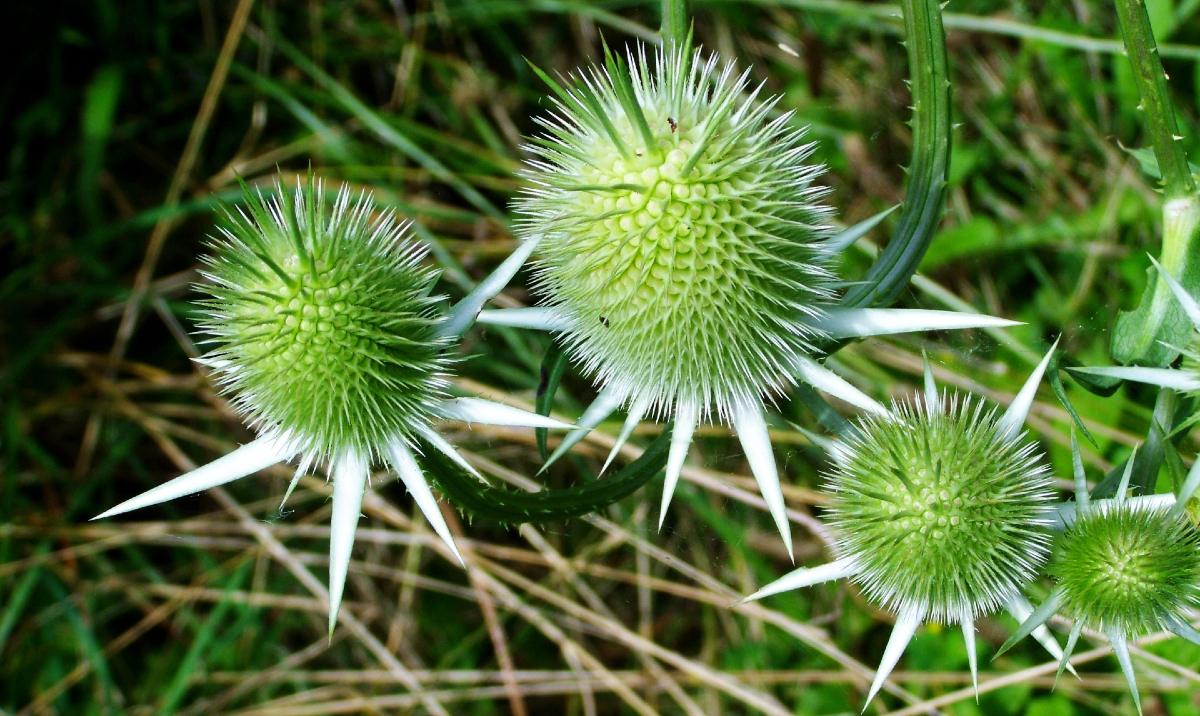Do you give heartworm or flea & tick prevention? Vaccinations? Take your dog for walks? Then this herb belongs in your pet’s bowl.
Exalted for its abilities to support the liver when it’s taxed by preventatives, medications, even allergies, here’s everything you need to know about Milk Thistle…
On The Agenda
What Milk Thistle Is...

While some thistles are harmful weeds, Milk Thistle’s one thistle you should pay attention to. It’s been used historically to treat liver disease and gallbladder issues in 2-leggers, and it can be used to benefit four-leggers, too.
It’s a flowering herb with white veins and prickly leaves named for the milky white sap that comes from the leaves when crushed. Milk Thistle is rich in nutrients but used primarily for silymarin, a combination of several active compounds within the seeds. Silymarin can be extracted from milk thistle seeds, or utilized by grinding up the entire seed.
Where Milk Thistle Comes From

You can find Milk Thistle in the US, South America, Africa, Australia, Asia, and Europe– where it was originally discovered. Most actually consider it to be a pesky weed since it can grow tall and thorny and it’s rather hardy, but its many uses make up for its prickly exterior.
How Milk Thistle Works
Working as an antioxidant, an anti-inflammatory, and protectant, milk thistle has profound effects for humans and animals alike.
Hepatoprotective
The prefix hepato relates to the liver, so it’s rather plain what milk thistle can do. As a hepatoprotective, milk thistle protects your whisker-toter and his liver from toxin damage that comes from the environment, pharmaceuticals, and more.
As much as you try to minimize toxins, they’re pretty much impossible to avoid altogether.
- Chemicals are put on or in them every month as preventatives
- Pesticides, herbicides, & household products
- Dogs drink from puddles, lick sidewalks, and have an eat first and ask questions later approach to all things that even moderately resemble something edible

Detoxifier
The active ingredient, silymarin, acts as an antioxidant reducing free radicals produced by waste byproducts. This creates the detoxifying effect that the liver thanks you for, since one of the liver’s biggest roles is detoxification.
Anti-Inflammatory

Anti-inflammatories are ahhh-mazing for every pet. They benefit everything from the heart to the immune system, and offer protection to the cardiovascular system and other organs like the liver.
But this one here is also a biggie for the allergy dog, so perk up pups. As every pet parent with an allergy dog can attest, allergy symptoms are awful for everyone involved. The environmental allergy dog who’s hot, inflamed, and greasy, needs that heat and inflammation brought down. With its anti-inflammatory and detoxification properties, Milk Thistle helps do just that.
Who Should Use Milk Thistle
Every Single Pet

It’s a staple you should include in your dog’s bowl for liver support. Use it quarterly for a system cleanse each season. Consider using it daily to support the liver’s natural detoxification process, since dogs are exposed to indoor/outdoor toxins, monthly preventatives, and annual vaccinations.
PRO TIP: Milk Thistle is also supremely important for any pet who has been taking corticosteroids and antihistamines or really any pharmaceutical on a daily basis for extended periods of time. Milk Thistle can protect the liver from future damage and repair existing damage by flushing out harsh and harmful toxins that accompany pharmaceuticals.
Why Herbsmith Milk Thistle is Best
Herbsmith Milk Thistle contains one simple ingredient. And that’s pure, 100% USDA organic Milk Thistle. Quality is key when it comes to anything you’re adding to your pet’s bowl. So are the standards you hold each ingredient to. Purity and authenticity need to be a priority because it’d be counterproductive to give a less-than-top-notch herb meant to detoxify. That has the potential to do more harm than good!
Here are the things a quality herb should be tested for:
- Sulfur content
- Microbial analysis
- Heavy metal analysis
- Pesticide analysis
Herbsmith Milk Thistle is simply fresh ground milk thistle seed rather than an extract. We want to utilize the whole seed, instead of just the active ingredient since the seed clearly has so many benefits. The seed is also rich in fiber and antioxidants which dampens any harsh effects silymarin can have on your pet’s body. (This does make the dosage a little different.)

How Dr. Bessent Uses Milk Thistle
As both a protectant and a detoxifier, Dr Bessent has used this versatile herb many ways– during any preventative applications like flea, tick & heartworm, pets who have high ALT levels, while pet’s take medications, are vaccinated, or for those who suffer from allergies.
For a Daily or Quarterly Detox
It can be given as a quarterly detox or used as a daily detoxifier long-term because of our pets’ daily toxin exposure. Detoxifying the system also supports the normal function of other vital organs to promote kidney, pancreas, and gallbladder health.

Daily
Use everyday, long-term
There is conflicting information about whether Milk Thistle can be used daily. What research actually shows is that milk thistle is the most effective when given prior to toxin exposure. And, several of Dr. Bessent’s patients used milk thistle daily throughout their entire lives as a proactive measure.
Quarterly
Use for 1 week every 3 months
For Immune Support
Reducing your pet’s toxic load helps to maintain a balanced immune system (the immune system isn’t working so hard fighting off invaders like environmental pollutants and pathogens then).
Daily
Use everyday, long-term
For Liver Support
Monthly Heartworm Prevention
Start 2 days before and continue for 2-3 days after treatment
Prescribed Medications
Start 2 days before and continue use until 2-3 days after the medication is discontinued.
Flea & Tick
Collar– Use continuously as long as the collar is on.
Oral– Start 2 days before and continue for 2 to 3 days after.
Topical– Use 2 days before and for 7 days after the time of application.
Vaccinations
Start 2 days before and continue for at least 2-3 days after

For High Alt Levels
Milk Thistle stimulates the growth of new liver cells to replace the dead or dying, reinforcing the liver when it’s taxed to give it the help it needs. It’s best to use daily to protect against toxins that stress the liver.

For the Allergy Dog
Both Eastern and Western veterinary practices know that the liver plays a crucial role when it comes to allergies.
Detoxifying the body actually helps to bring down the heat and inflammation that the hyper-reaction is causing. And we all know which organ we’re going to be helping.
Since the goal is to reduce heat and inflammation, Dr. Bessent uses milk thistle with a combination of nutraceuticals and targeted herbs to bring down the heat and get to the root of environmental allergies.
This can take time, but when you bring the body back to homeostasis you’re giving your allergy dog relief long-term.

For Seasonal Allergies
Daily nutraceuticals should be given year-round. Nutraceuticals like Omega 3 (EPA & DHA) and Omega 6 (GLA) daily to soothe, repair, and build skin & coat integrity for the allergy dog.
Use Milk Thistle with cooling, calming, and yin-tonifying herbs two to three months prior to allergy season and continue until two months after allergy season ends.
The combination of herbs offers allergy dogs and cats much-needed relief while rebalancing the immune system. That way the body’s defenses don’t continue to overreact in the future when exposed to everyday allergens.
For Year-Round Allergies
Daily nutraceuticals should be given year-round. Nutraceuticals like Omega 3 (EPA & DHA) and Omega 6 (GLA) daily to soothe, repair, and build skin & coat integrity for the allergy dog.
Use Milk Thistle with cooling, calming, and yin-tonifying herbs daily until allergies are resolved.

Herbs (with very few exceptions) will always have the biggest impact when combined. Milk Thistle is the outlier. It can be used in combination, as is the case with the allergy dog, but as a single herb, it offers such benefits for every carnivore’s health and wellbeing. Whether you use it daily, quarterly, as needed– it’s an herb that needs to be in the bowl.
Share this Post

Dr. Chris Besent
Chris Bessent, DVM, MSOM, Dipl. OM, L.Ac. has over thirty years of experience in veterinary medicine including certificates in veterinary acupuncture, veterinary chiropractic and veterinary Chinese herbology. Imbued with Eastern philosophy and the knowledge that food is the foundation of health, Dr. Bessent also received her degree in veterinary nutrition and began to formulate recipes fit for a carnivore from nothing but whole foods. Currently, she divides her time between the Simple Food Project and Herbsmith, both of which are owned and operated out of her facilities in southeastern Wisconsin.

Kira - Writer
Kira is a writer who lives in Montana. She takes advantage of the mountains and river—and spends a lot of time outdoors. She has a giant shaggy dog who’s the perfect sidekick. And spends her free time making things. Crafting, sewing, and jewelry making are favorites!

Kayla - Editor
Kayla is the Content Editor for Herbsmith. She has a cat named Professor Cat-Faced Meowmers, who goes by Kitty, and a goof of a dog, named Duck. She stays busy biking trails, playing board games, and searching for the next best craft beer.





4 Responses
My dog is diabetic,is using milk thistle safe for him?
Hello Trudy, it would be safe to use Milk Thistle with your pup! The herb acts as both a protectant & detoxifier, stimulating new liver cells’ growth to replace the dead or dying to support the liver.
need another way to deliver this besides putting it on her food. she will not eat it
Hello Judith! We have some great tips and tricks! 🙂
You can try rolling it up into a meatball and giving it as a treat, adding it with bone broth, or you can mix it with another type of wet food.
If she is a fan of cottage cheese or plain Greek yogurt that may work.
Also, just consider how many snacks you’re giving throughout the day, since a hungry dog is more likely to eat.
Sometimes, if they are not used to herbs it can be a little overwhelming, so starting with a smaller dose and working your way up can help, too. 😊
Comments are closed.